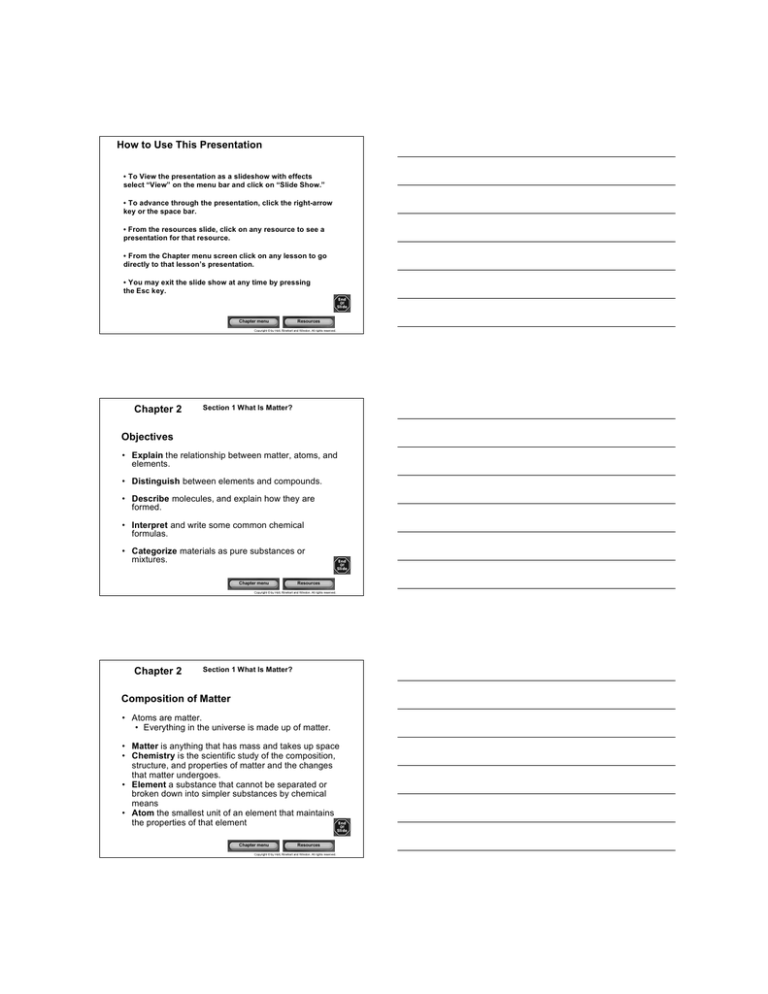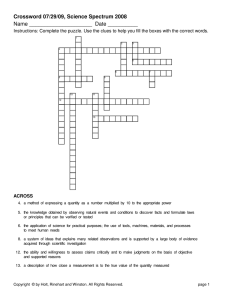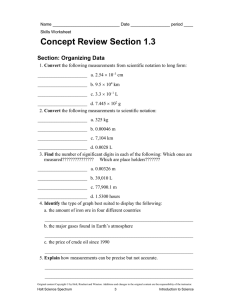
How to Use This Presentation
• To View the presentation as a slideshow with effects
select “View” on the menu bar and click on “Slide Show.”
• To advance through the presentation, click the right-arrow
key or the space bar.
• From the resources slide, click on any resource to see a
presentation for that resource.
• From the Chapter menu screen click on any lesson to go
directly to that lesson’s presentation.
• You may exit the slide show at any time by pressing
the Esc key.
Chapter menu
Resources
Copyright © by Holt, Rinehart and Winston. All rights reserved.
Chapter 2
Section 1 What Is Matter?
Objectives
• Explain the relationship between matter, atoms, and
elements.
• Distinguish between elements and compounds.
• Describe molecules, and explain how they are
formed.
• Interpret and write some common chemical
formulas.
• Categorize materials as pure substances or
mixtures.
Chapter menu
Resources
Copyright © by Holt, Rinehart and Winston. All rights reserved.
Chapter 2
Section 1 What Is Matter?
Composition of Matter
• Atoms are matter.
• Everything in the universe is made up of matter.
• Matter is anything that has mass and takes up space
• Chemistry is the scientific study of the composition,
structure, and properties of matter and the changes
that matter undergoes.
• Element a substance that cannot be separated or
broken down into simpler substances by chemical
means
• Atom the smallest unit of an element that maintains
the properties of that element
Chapter menu
Resources
Copyright © by Holt, Rinehart and Winston. All rights reserved.
Chapter 2
Section 1 What Is Matter?
Elements in the Human Body
Chapter menu
Resources
Copyright © by Holt, Rinehart and Winston. All rights reserved.
Chapter 2
Section 1 What Is Matter?
Atom
Chapter menu
Resources
Copyright © by Holt, Rinehart and Winston. All rights reserved.
Chapter 2
Section 1 What Is Matter?
Composition of Matter, continued
• Elements combine chemically to form a compound.
• Compound a substance made of atoms of two or
more different elements that are chemically combined
Chapter menu
Resources
Copyright © by Holt, Rinehart and Winston. All rights reserved.
Chapter 2
Section 1 What Is Matter?
Composition of Matter, continued
• Compounds have unique properties.
• Every compound is different from the elements it
contains.
• When elements combine to form a specific
compound, they always combine in the same
proportions.
Chapter menu
Resources
Copyright © by Holt, Rinehart and Winston. All rights reserved.
Chapter 2
Section 1 What Is Matter?
Composition of Matter, continued
• A molecule acts as a unit.
• Atoms can join together to make millions of
molecules.
• Molecules are the smallest unit of a substance that
keeps all all of the physical and chemical properties
of that substance.
Chapter menu
Resources
Copyright © by Holt, Rinehart and Winston. All rights reserved.
Chapter 2
Section 1 What Is Matter?
Molecule
Chapter menu
Resources
Copyright © by Holt, Rinehart and Winston. All rights reserved.
Chapter 2
Section 1 What Is Matter?
Composition of Matter, continued
• Chemical formulas represent compounds and
molecules.
• A chemical formula shows how many atoms of
each element are in a unit of a substance.
• Chemical formula a combination of chemical
symbols and numbers to represent a substance.
Chapter menu
Resources
Copyright © by Holt, Rinehart and Winston. All rights reserved.
Chapter 2
Section 1 What Is Matter?
Pure Substances and Mixtures
• Mixtures are formed by mixing pure substances.
• Pure substance a sample of matter, either a single
element or a single compound, that has definite
chemical and physical properties
• Mixture a combination of two or more substances
that are not chemically combined
Chapter menu
Resources
Copyright © by Holt, Rinehart and Winston. All rights reserved.
Chapter 2
Section 1 What Is Matter?
Pure Substances and Mixtures, continued
Mixtures are classified by how thoroughly the
substances mix.
• Heterogeneous mixture substances aren’t mixed
uniformly and are not evenly distributed
• Homogeneous mixture substances are evenly
distributed, and the mixture is the same throughout
• Miscible substances that can be mixed
• Immiscible substances that cannot be mixed
Chapter menu
Resources
Copyright © by Holt, Rinehart and Winston. All rights reserved.
Chapter 2
Section 1 What Is Matter?
Pure Substances and Mixtures, continued
• Gases can mix with liquids.
• Air is a mixture of gases.
• Examples of gases mixed with liquids include
• carbonated drinks
• oxygen dissolved in water
• foam
Chapter menu
Resources
Copyright © by Holt, Rinehart and Winston. All rights reserved.
Chapter 2
Section 2 Properties of Matter
Objectives
• Distinguish between the physical and chemical
properties of matter, and give examples of each.
• Perform calculations involving density.
• Explain how materials are suited for different uses
based on their physical and chemical properties, and
give examples.
• Describe characteristic properties, and give
examples.
Chapter menu
Resources
Copyright © by Holt, Rinehart and Winston. All rights reserved.
Chapter 2
Section 2 Properties of Matter
Physical Properties
• Physical properties describe matter.
• Some physical properties of matter include shape,
color, size, mass, volume, density, melting point
and boiling point.
• Melting point the temperature and pressure at which
a solid becomes a liquid
• Boiling point the temperature and pressure at which
a liquid becomes a gas
• State the physical form in which a substance exists,
such as solid, liquid, or gas
Chapter menu
Resources
Copyright © by Holt, Rinehart and Winston. All rights reserved.
Chapter 2
Section 2 Properties of Matter
Three States of Water
Chapter menu
Resources
Copyright © by Holt, Rinehart and Winston. All rights reserved.
Chapter 2
Section 2 Properties of Matter
Physical Properties, continued
• Density is a physical property.
• Density is a measurement of how much matter is
contained in a certain volume of a substance.
• A substance with a low density is “light” and a
substance with a high density is “heavy” in
comparison to other substances of the same
volume.
• Density the ratio of the mass of a substance to the
volume of a substance
Chapter menu
Resources
Copyright © by Holt, Rinehart and Winston. All rights reserved.
Chapter 2
Section 2 Properties of Matter
Physical Properties, continued
• Density is often measured in units of g/cm3
• The equation for density is D = m/V
• Density = mass/volume
• The density of a liquid or solid is usually reported
in units of grams per cubic centimeter (g/cm3 )
Chapter menu
Resources
Copyright © by Holt, Rinehart and Winston. All rights reserved.
Chapter 2
Section 2 Properties of Matter
Physical Properties, continued
• Physical properties help determine uses.
• Physical properties are used to select substances
that may be useful.
• Examples of useful physical properties include:
• low freezing point
• high boiling point
• water resistance
• flexibility
• electrical conductor
• heat conductor
Chapter menu
Resources
Copyright © by Holt, Rinehart and Winston. All rights reserved.
Chapter 2
Section 2 Properties of Matter
Chemical Properties
• Chemical properties describe how a substance
reacts.
• Chemical properties are related to the specific elements
that make up substances.
• Chemical properties describe how a substance changes
into a new substance when in contact with other elements.
• Reactivity the ability of a substance to combine
chemically with another substance
• Flammability the ability of a substance to react in
the presence of oxygen and burn when exposed to
a flame
Chapter menu
Resources
Copyright © by Holt, Rinehart and Winston. All rights reserved.
Chapter 2
Section 2 Properties of Matter
Reactivity
Chapter menu
Resources
Copyright © by Holt, Rinehart and Winston. All rights reserved.
Chapter 2
Section 2 Properties of Matter
Comparing Physical and Chemical Properties
• Characteristic properties help to identify and classify
substances.
• The table below compares some physical and
chemical properties.
Chapter menu
Resources
Copyright © by Holt, Rinehart and Winston. All rights reserved.
Chapter 2
Section 3 Changes of Matter
Objectives
• Explain physical change, and give examples of
physical change.
• Explain chemical change, and give examples of
chemical changes.
• Compare and contrast physical and chemical
changes.
• Describe how to detect whether a chemical change
has occurred.
Chapter menu
Resources
Copyright © by Holt, Rinehart and Winston. All rights reserved.
Chapter 2
Section 3 Changes of Matter
Physical Changes
• Physical changes do not change a substance’s
identity.
• Physical changes affect only the physical
properties of a substance.
• Physical change a change of matter from one form
to another without a change in chemical properties
Chapter menu
Resources
Copyright © by Holt, Rinehart and Winston. All rights reserved.
Chapter 2
Section 3 Changes of Matter
Physical Changes, continued
• Dissolving is a physical change.
• When a substance dissolves, the molecules of the
substance do not change.
• Dissolving a solid in a liquid, a gas in a liquid, or a
liquid in a liquid are all physical changes.
Chapter menu
Resources
Copyright © by Holt, Rinehart and Winston. All rights reserved.
Chapter 2
Section 3 Changes of Matter
Physical Changes, continued
• Mixtures can be physically separated.
• Because mixtures are not chemically combined,
each component of the mixture has the same
chemical makeup it had before the mixture was
formed.
• Mixtures can be separated based on their physical
properties.
Chapter menu
Resources
Copyright © by Holt, Rinehart and Winston. All rights reserved.
Chapter 2
Section 3 Changes of Matter
Separating Mixtures
Chapter menu
Resources
Copyright © by Holt, Rinehart and Winston. All rights reserved.
Chapter 2
Section 3 Changes of Matter
Chemical Changes
• Chemical changes happen everywhere.
• Examples of chemical changes include:
• burning
• rusting
• digesting
• decomposing
• Chemical change a change that occurs when a
substance changes composition by forming one or
more new substances
Chapter menu
Resources
Copyright © by Holt, Rinehart and Winston. All rights reserved.
Chapter 2
Section 3 Changes of Matter
Chemical Changes
Chapter menu
Resources
Copyright © by Holt, Rinehart and Winston. All rights reserved.
Chapter 2
Section 3 Changes of Matter
Chemical Changes, continued
• Chemical changes form new substances that have
different properties.
• The results of a chemical change are substances
that have completely different properties from the
properties of the original substances.
Chapter menu
Resources
Copyright © by Holt, Rinehart and Winston. All rights reserved.
Chapter 2
Section 3 Changes of Matter
Chemical Changes, continued
• Chemical changes can be detected.
• Changes in physical properties can be an
indication of a chemical change.
• Examples include:
• change of color
• change of smell
• fizzing
• production of heat
• production of sound
• production of light
Chapter menu
Resources
Copyright © by Holt, Rinehart and Winston. All rights reserved.
Chapter 2
Section 3 Changes of Matter
Chemical Changes, continued
• Chemical changes cannot be reversed by physical
changes.
• Because new substances are formed in a
chemical change, the change cannot be reversed
by using physical changes.
• Many chemical changes are impossible to reverse,
for example it is impossible to “unbake” a cake.
Chapter menu
Resources
Copyright © by Holt, Rinehart and Winston. All rights reserved.
Chapter 2
Section 3 Changes of Matter
Chemical Changes, continued
• Compounds can be broken down through chemical
changes.
• Some compounds undergo chemical changes to
form elements, others break down to form simpler
substances.
Chapter menu
Resources
Copyright © by Holt, Rinehart and Winston. All rights reserved.





